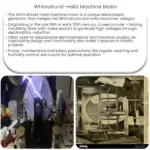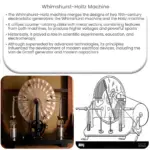The Töpler-Holtz machine motor is a 19th-century electrostatic generator that produced high voltage sparks for early electrical research.

Töpler-Holtz Machine Motor: An Intriguing Piece of Electrostatic History
Introduction
The Töpler-Holtz machine motor is an electrostatic generator with a rich history, invented in the 19th century by two German physicists, August Töpler and Julius Holtz. This device played a vital role in early electrical research and experimentation, allowing scientists to produce high voltage electrostatic charges. In this article, we will delve into the origins and working principles of the Töpler-Holtz machine, as well as its significance in the history of electrical engineering.
Origins and Development
The Töpler-Holtz machine emerged from the field of electrostatics, which is the study of the behavior of stationary electric charges. In the mid-19th century, August Töpler and Julius Holtz independently designed their electrostatic machines, which were later combined into one device. The result was an improved version of the earlier Wimshurst machine, offering a more reliable and efficient way to generate electrostatic charges.
August Töpler was a German physicist, born in 1836, who made significant contributions to the field of electrostatics and was the first to experiment with the principle of influence machines. Julius Holtz, also a German physicist, was born in 1833 and made various contributions to the study of electricity and magnetism. Their combined efforts led to the development of the Töpler-Holtz machine motor, which gained popularity and widespread use in the late 19th and early 20th centuries.
Working Principles
The Töpler-Holtz machine motor operates on the principle of electrostatic induction, using two counter-rotating disks made of glass or other insulating materials. The disks are mounted on a common axis, and a system of brushes and metallic sectors collects and redistributes the electrostatic charges generated during operation.
As the disks rotate, one disk acquires a positive charge and the other a negative charge. The charges are then transferred to the metallic sectors and eventually collected by the brushes. The redistribution process intensifies the charges, ultimately resulting in the creation of a high voltage spark across the spark gap, which is typically connected to the machine’s terminals.
Applications and Significance
The Töpler-Holtz machine motor was an essential tool for early electrical research and experimentation. It allowed scientists to investigate the properties of electricity, such as voltage, current, and resistance, in a controlled environment. The high voltage sparks generated by the machine were used for various experiments, such as igniting flammable materials, producing x-rays, and studying electrical discharge in gases.
Beyond its applications in scientific research, the Töpler-Holtz machine motor also played a key role in the development of early electrotherapy. It was used by physicians to treat various medical conditions through the application of electrical energy, a practice that eventually paved the way for modern electrotherapy techniques.
Decline and Legacy
With the advent of the 20th century and the rapid development of electrical engineering, the Töpler-Holtz machine motor gradually fell out of favor. The invention of more efficient and reliable sources of electrical energy, such as the dynamo and the transformer, rendered the Töpler-Holtz machine obsolete. As a result, its usage in scientific research and medical applications declined significantly.
Despite its decline, the Töpler-Holtz machine remains an important piece of electrical engineering history. It symbolizes the ingenuity and innovation of the 19th-century scientists who made groundbreaking discoveries in the field of electrostatics. Today, Töpler-Holtz machines can be found in museums and private collections, serving as a testament to the early days of electrical research and experimentation.
Modern Electrostatic Generators
Although the Töpler-Holtz machine motor is no longer used in modern research or medical applications, the principles behind electrostatic generators continue to be explored and developed. Contemporary electrostatic generators, such as the Van de Graaff generator and the Pelletron, are based on similar principles of electrostatic induction and charge redistribution.
These modern devices are used in various applications, including particle acceleration, high-voltage testing, and electrostatic painting. They demonstrate the enduring relevance of electrostatic principles, first explored by pioneers like Töpler and Holtz, in today’s cutting-edge technologies.
Conclusion
The Töpler-Holtz machine motor represents a fascinating chapter in the history of electrical engineering. Although it has been superseded by more advanced technologies, the machine played a crucial role in the early understanding of electricity and its properties. The legacy of the Töpler-Holtz machine endures through modern electrostatic generators, which continue to harness the power of electrostatic induction for a range of scientific and industrial applications.
In conclusion, the Töpler-Holtz machine motor serves as an important reminder of the innovations and discoveries that paved the way for our current understanding of electricity. By studying its origins, working principles, and historical significance, we can better appreciate the progress that has been made in electrical engineering and the ongoing importance of electrostatic principles in modern technology.




